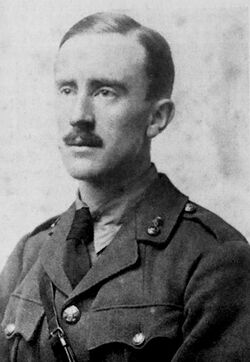Goldogrin
| Goldogrin | |
|---|---|
| Created by | J. R. R. Tolkien |
| Date | c. 1910 – c. 1920 |
| Setting and usage | The fictional world of Middle-earth |
| Users | None |
| Purpose | constructed languages
|
| Latin; Elvish writing systems: (mainly) sarati. | |
| Language codes | |
| ISO 639-3 | None (mis) |
| Glottolog | None |
Goldogrin is a constructed language devised by J. R. R. Tolkien and used in his secondary world, often called Middle-earth. Goldogrin was spoken by the Second Clan of Elves, called Goldorim in that language, Gnomes in English (whence Gnomish for their language). In The Book of Lost Tales the second clan of Elves was also known in Elfin as the Noldoli and their language was called Noldorin.[1]
External history
Tolkien was interested in languages from an early age, and developed several constructed languages while still a teen. Eventually, as a young adult, he created an entire family of constructed languages spoken by Elves and a secondary world where these could evolve.
Goldogrin was created c. 1915. It was Tolkien's first constructed language inspired by the Celtic languages. He wrote a substantial dictionary of Gnomish and a grammar.[2] At the same time Tolkien conceived a History of the Elves and wrote it in the Book of Lost Tales.
Gnomish was spoken by the Gnomes, the Second Clan of Elves. At the same time, Elfin was the other tongue spoken by the great majority of the Elves of the Lonely Isle.
The beginning of the "Name-list of the Fall of Gondolin", one of the Lost Tales, gives a good example of both languages (Gnomish and Elfin):
| “ | Here is set forth by Eriol at the teaching of Bronweg's son Elfrith or 'Littleheart' (and he was so named for the youth and wonder of his heart) those names and words that are used in these tales from either the tongue of the Elves of Kor as at the time spoken in the Lonely Isle, or from that related one of the Noldoli their kin whom they wrested from Melko. Here first are they which appear in the Tale of Tuor and the Exiles of Gondolin, first among these those ones in the Gnome-speech (lam Goldrin).
Ainon now these were great beings who dwelt with Ilúvatar as the Elves name Him (but the Gnomes Ilador or Ilathon) ere the world grew, and some of these dwelt after in the world and ere the Gods or Ainur as say the Elves.[3] |
” |
A few years later, c. 1925, Tolkien began anew the grammar and lexicon of the tongue of the Gnomes. He dropped the words Goldogrin and lam Goldrin in favor of Noldorin (a Quenya word already sparingly used for his Gnomish tongue), and Noldor. This was the second conceptual stage of the language which much later Tolkien called Sindarin.
Internal history
Grammar
The Gnomish grammar (Lam na Ngoldathon) describes the dialect spoken by the Gnomes of Tol Erethrin (the Gnomish name of Tol Eressëa). It was written by a man (not an Elf) contemporary with the fifth century mariner Eriol who came to Tol Eressëa.
Mutations
Goldogrin has a complex series of mutations. The most important is called "Grammatical Mutation" (or GM) for it was generalized to a rule and is used in many case not justified purely on phonological grounds.
| Basic | GM |
|---|---|
| b | v (bh) |
| d | dh |
| g | ’ |
| gw | ’w |
| p | b |
| t | d |
| c | g |
| cw | gw |
| h | ch |
The apostrophe ’ indicates elision.
The article
| Preconsonantal | Prevocalic | |
|---|---|---|
| Nominative | i | in and n |
| Genitive | na | nan and archaically ina(n) |
| Dative | i or ir | ir |
Thus: Egla "Elf", in·Egla "the Elf"; bess "wife", i·vess "the wife".
- I·waneth na·dalwint gloss an Idril, "The beauty of the white feet of Idril".
Vocabulary
| Meaning | Goldogrin | Pronunciation |
|---|---|---|
| earth, soil | mar | [ˈmɑr] |
| sky | telm | [ˈtɛlm] |
| water | nenn | [ˈnɛn] |
| flame | bleg | [ˈblɛɡ] |
| husband | benn | [ˈbɛn] |
| wife | bess | [ˈbɛs] |
| eat | mad- | [ˈmɑd] |
| a drink | suith | [ˈsuiθ] |
| great | beleg | [ˈbɛlɛɡ] |
| family | nothri | [ˈnɔθri] |
| bee | nios | [ˈnios] |
| hat | tôd | [ˈtoːd] |
| Gold | n'auro | [ˈnaʊro] |
See also
- Languages constructed by J. R. R. Tolkien
- Elvish languages (Middle-earth)
References
External links


